Italy can offer unparalleled dining experiences, but like any country that is not your own, you might have trouble discovering where those experiences are without a little help. There are some things that you should keep in mind when dining out and some strategies to use when deciding where to eat and what to order that can assist you in making sure your Italian food adventures live up to your expectations! There is no shortage of places to buy food in Italy, the options are endless really, but if you follow our tips you’ll be prepared to get the most out of every opportunity you have to eat in this gastronomically rich country.
1) Prioritize what you want to eat so you know where to eat
What are you in the mood for? A sit down restaurant, a caffé (coffee shop), a sandwich on the go, or an attempt at making your own meal from local ingredients? You can spend hours trying to figure out where to eat in Italy simply because there are so many choices. Making a list of some of the different foods you want to try before you get to Italy will give you some time to figure out where those foods are typically available and make it easier to determine where you should be going to find them.
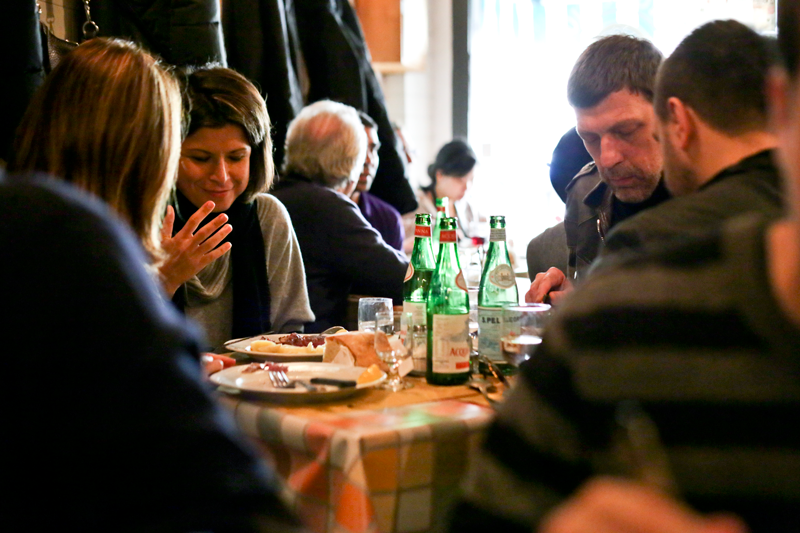
Sit-down restaurants vary in formality, but if you are in the mood for a good pasta and meat dish, a restaurant is your best bet. Even if you are only in the mood for a little regional charcuterie and cheese with a glass of wine, the appetizer menu in any reputable restaurant is likely to have you covered. On the other hand, if you are in a hurry, you’ll want to go to a bar or paninoteca, where you can find a good, cheap sandwich and sometimes even a plate of pasta.
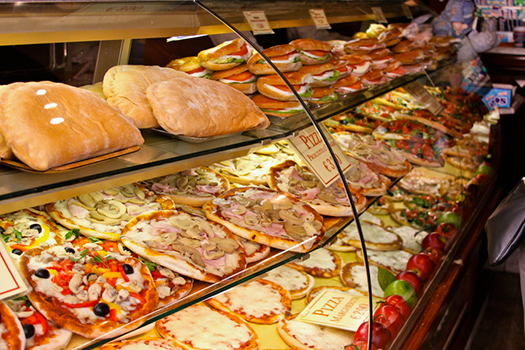 Pizza and panini via Brian & Jaclyn Drum under CC license.
Pizza and panini via Brian & Jaclyn Drum under CC license.
If it’s pizza that you’re craving, then you have a few choices. Pizza d’asporto (take out) is good if you have a scenic dining destination in mind, say, outside in a park. Pizza a trancio (also à taglio) or pizza rustica, is a variation on d’asporto that sells pizza by the slice. Finally, a pizzeria, is the authentic sit-down Italian pizza experience that the savvy traveler searches for.
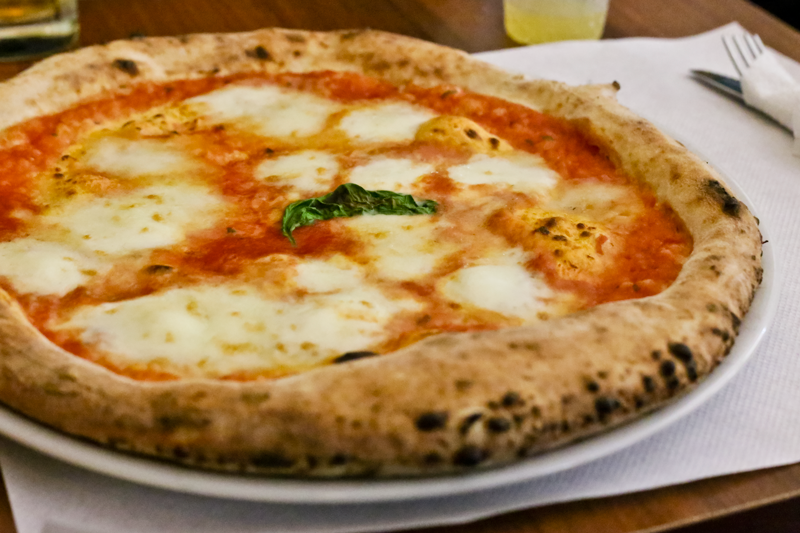 If you are looking for pizza like this, only a Neapolitan-style pizzeria will do.
If you are looking for pizza like this, only a Neapolitan-style pizzeria will do.
Wherever you go in Italy, you’ll notice that most places serving food post a menu outside, so take a look before entering to determine if the food options, as well as the prices, suit what you are looking for. In tourist-frequented cities, it’s common for a charming young Italian man to swoop over and usher you into a restaurant before you get a chance to look at a menu; don’t feel rushed to make a decision, make sure they are offering what you are in the mood for and take your time deciding where to eat!
2) Italians aren’t timid when it comes to coffee and hot chocolate
When you walk into a caffé or bar in the morning and order un caffé (coffee), don’t be surprised when what you get is an espresso; that is what Italians call coffee. When Italians go to countries that serve coffee in the American style, that is, large mugs filled with drip coffee, most of them call it acqua sporca (dirty water), alluding to the fact that, compared to what they drink, it is mostly water. Espresso is a much more concentrated drink, thus, it’s stronger in terms of the caffeine it delivers and it has an intense, deep, coffee flavor. Although you may not be used to it, Italian coffee is prized as some of the best in the world, alongside coffees from many of the top-ranked South American countries.
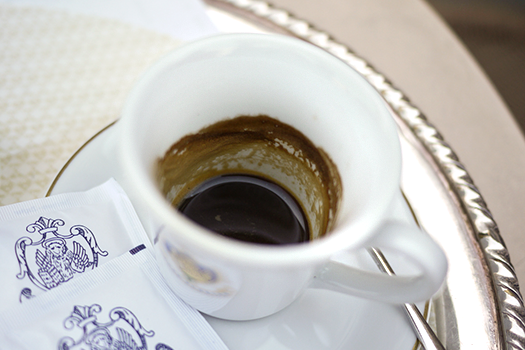
Espresso at Venice’s famed Caffe Florian via Richard under CC license.
If it’s an American-style coffee you are after, know that you will only find it in tourist-trodden cities and hotels that serve continental breakfasts, not in the small towns that offer the richest gastronomic opportunities. Also, you should be advised that just because what you want is an American-style coffee doesn’t mean that it is called an Americano. Asking for an Americano will get you a shot of espresso in a glass which is then filled to the brim with water. If you like espresso, indulge to your heart’s content, there are no limits in Italy: ask the barman for a doppio if you want a double shot, or a stretto if you want a super concentrated half shot. If espresso is a little too strong for your taste, you can order a cappuccino (espresso with frothed milk), but be aware that it is only acceptable to have cappuccino at breakfast and never with or after any other meal.
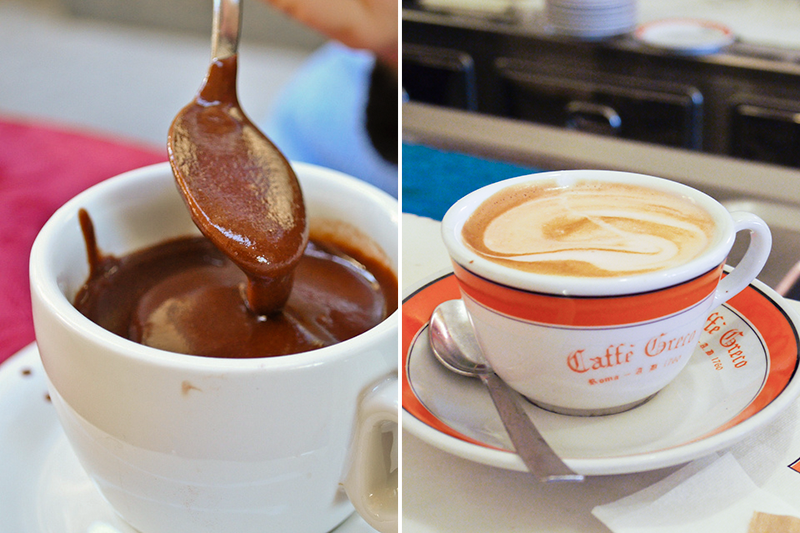
Italian hot chocolate via Frédérique Voisin-Demery & cappuccino via Richard, under CC license.
If you aren’t in the mood for coffee at all, Italian hot chocolate is another menu item that, although you won’t find it everywhere, is something you should try. The hot chocolate that many people are accustomed to is thin, milky, and usually made with either chocolate syrup or cocoa powder. The hot chocolate that you find in Italy is very thick and creamy, almost as if they had melted a pure bar of chocolate in a pot and mixed it with frothed milk. It is decadent, sweet and utterly delicious, but it is also very rich and nothing like what your are probably used to drinking. There are some specialty bars that serve different kinds of hot chocolate, both white and dark, with flavors like raspberry, hazelnut, orange, and mint. If you are a chocolate lover, don’t miss an opportunity to try Italian hot chocolate, it will change the way you look at chocolate forever.
3) There are still Italians who like a cigarette with their meal

If you decide to sit outside, choose your seat wisely. Photo via Jon Shave under CC license.
Like many modern countries, smoking inside of places that serve food has been banned in Italy. But if there is any sort of outdoor patio, it’s game on for the smokers. If you choose to eat outside, you are likely to see many people smoking and it is perfectly legal for them to do so. If you are bothered by the smell of smoke, pay special attention when you sit down to choose a table away from smokers, although you won’t be able to control who sits down in your area after you. If you really can’t stand the idea of someone smoking while you are trying to enjoy your meal, your best option is to forgo an outdoor table and eat inside, where smoking is strictly prohibited. If you are on the fence, take a look at the patio before choosing where to sit, if there is a large concentration of people smoking you will probably find it a better choice to sit indoors.
4) Be aware of il coperto
Il coperto is a term used in Italy meaning cover, or seat taken at a restaurant. Do not be surprised when you get your bill and there is an additional €1 or so for each person sitting a the table. Il coperto comes from a long history and tradition of serving food to hungry travelers. During cold winters, people would go into restaurants, osterie, and trattorie simply to take a breath, get out of the cold, and have a small bite to eat. The people operating these places began to charge extra for patrons to sit down at the tables as often times there wasn’t space for everyone. Sitting down became a sort of luxury option, thus reducing the problem of overcrowded tables full of squatters that had no intentions of eating a proper meal.
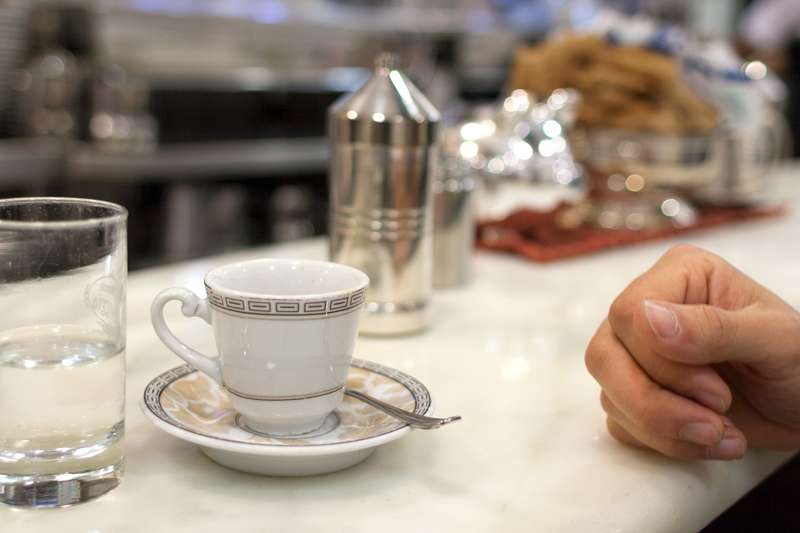
To avoid “il coperto”, have your coffee at the “banco”. Photo via Tim Lucas under CC license.
Even today, there are plenty of places where you can eat with the option of either siting or standing, just know that sitting will cost a little bit more. You should also determine what il coperto is before deciding to take a seat, some places take advantage of the fact that non-Italians don’t always know about il coperto and set the price unusually high, betting that people won’t notice until the bill comes and it’s already too late. At bars and caffés in particular, you might not find a per person coperto, but you’ll notice that the prices are completely different for the items you order depending on if you stand or sit, so look for columns labeled banco (what you pay when you stand at the bar) and tavolo (what you pay when you sit at a table) to know what to expect.
5) Bread isn’t free in Italy
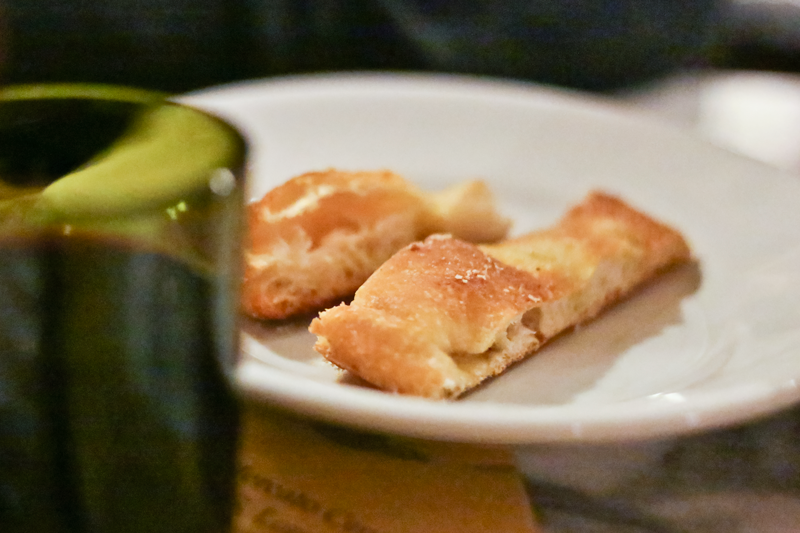
Another unexpected charge you are likely to incur while dining in Italy is the bread charge. In many places, people are used to any bread that is set on the table being free. This is not the case in Italy, whether the bread in question is a fresh cut loaf straight out of the oven or a small packet of bread sticks. The bread charge varies from restaurant to restaurant, but you can expect to pay anywhere from €1 to €2 per pack of bread sticks, per person or per basket of bread and any additional bread basket you request after the first will be charged accordingly. Depending on the restaurant, you might find il coperto and bread charged for separately or together as pane e coperto. The extra money spent here and there on pane e coperto can certainly add up, however, the fact that you pay these little fees, in a sense, compensates for another extra that many people count on paying when they go for a meal…
6) Italians do not tip!
In the United States, appreciation for good service received in a restaurant, whether your waiter stands by attentively with crossed palms or is just exceptionally friendly, is shown by leaving a generous tip. While standard tipping practices are disputed by some, it is generally accepted that you should tip an additional 10 – 20% of the total bill, which can end up being quite costly. A tip is, of course, a small price to pay for a fantastic dining experience, just as the absence of a standard tip is indeed a way to let a server know that your experience was less than satisfactory.
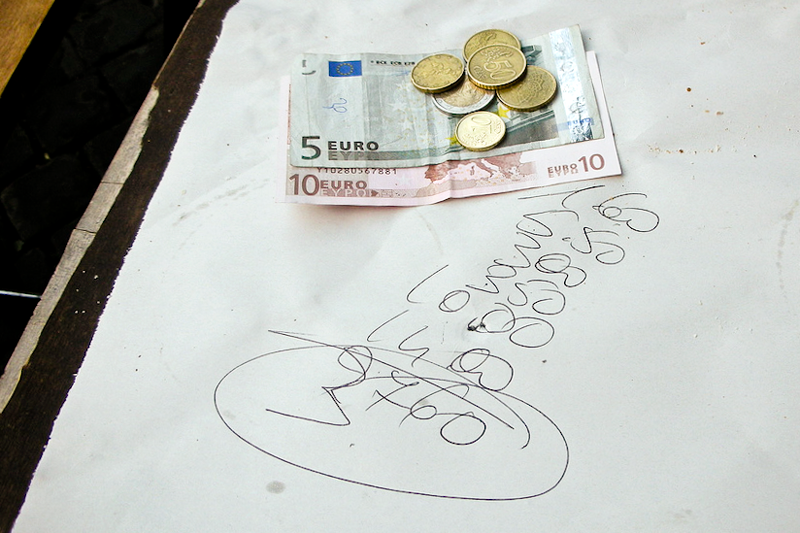
Photo via Antonello Tanteri under CC license.
Although tipping isn’t customary in Italy, no one will get mad at you for doing it. If you are concerned with fitting in, you should know that leaving some extra money on the table at the end of your meal will make it abundantly clear that you are a foreigner, especially in the case of a 10 – 20% tip. Because tipping isn’t something that is done in Italy, no one will give you a nasty look for not tipping, even if they already know you are a foreigner. As we see it, the important decision to make when it comes to tipping in a place where no one tips is more about saving your money for what you went to that restaurant for in the first place: great food. Instead of telling the restaurant how much you enjoyed your meal by leaving a tip, tell them by ordering that mouthwatering desert that you didn’t think was in your budget, it is now!
7) Avoid places with menus written in anything but Italian
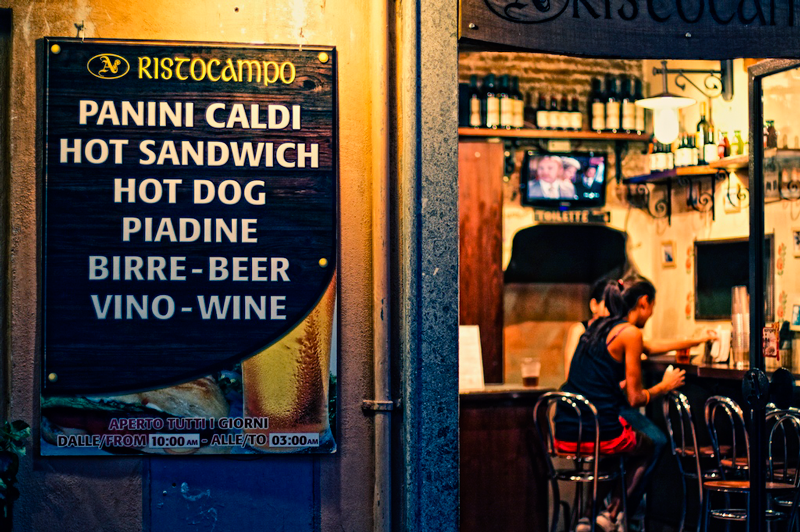
If English doesn’t hint that a place caters to foreigners, listing a hot dog as a selling point ought to. Photo via Michiel Jelijs under CC license.
“But I don’t speak Italian.” We know firsthand how daunting it can be to go to a place that only has menus written in the native language, especially when that language is one that you don’t even vaguely understand. However, the fact that a menu is not written in English or any number of other non-native languages is not necessarily an indicator that the staff doesn’t speak your language. If you are looking for a true Italian dining experience, you won’t find it in a place that caters to foreigners. Restaurants with menus in other languages often intentionally target foreigners; the menus are made according to the foreign palate in order to attract tourists to the restaurant, and, in Italy, the emphasis in these sorts of places is on quantity and not quality. Small, hole-in-the-wall restaurants are where you want to go for a genuine taste of Italy. Even if you are intimated by the language barrier, do your best to speak what you know to the hosts and servers and they will treat you like family; in this case, a few foreign words can go a long way.
8) Respect the produce
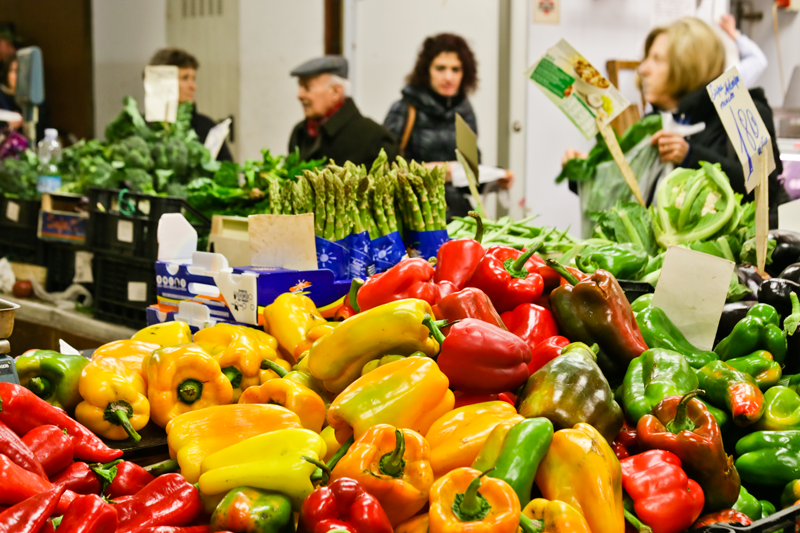
Say you have a long day of sightseeing in front of you and pass by a little fruit stand or local market to grab some food on the go. Before you reach out to pick something, think twice. It is almost never acceptable to touch produce yourself in Italy. The most common practice when shopping for produce is that you tell the vendor, or point to, what you would like and they will pick your produce for you. When you are asking for produce by weight, it’s important to remember that things are weighed in kilos in Italy rather than pounds, so you should ask for roughly half of what you would ask for in pounds. Once in a while it is permitted to pick produce yourself, usually in grocery stores. Even when choosing your own food is allowed, there will be boxes of gloves around that you are expected to put on before touching anything. If you end up somewhere that allows you to pick your own produce, it will likely be the case that you are also the person who is responsible for weighing each type of item and labeling it with a sticker printed out by the scale. If you get to the checkout stand and have not done this, they won’t know what to charge you for your selection.
9) Respect where your food comes from
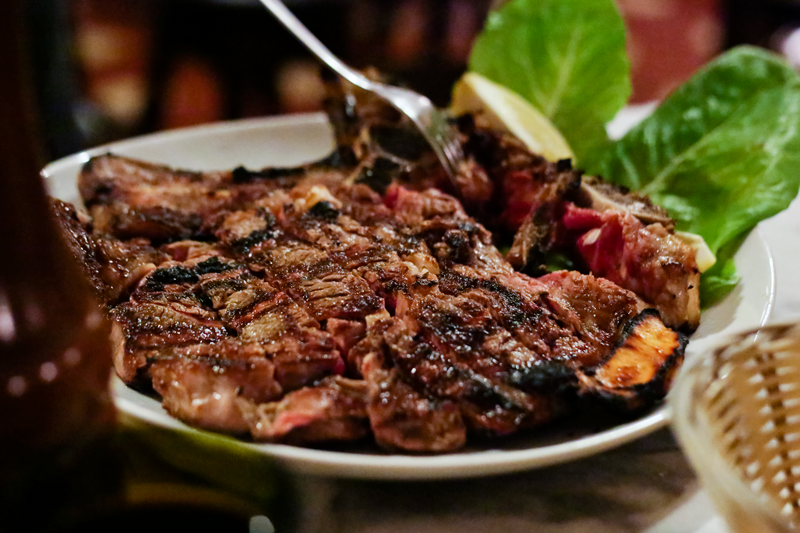
The legendary Bistecca alla Fiorentina, just 4 simple ingredients, meat from the native Chianina cattle, extra virgin olive oil, salt and pepper.
Have you ever wondered what the secret to Italian cooking is? Wondering why Italian food tastes so much better in Italy? One of the most important factors when it comes to making delicious and authentic Italian cuisine, and one that is no secret among Italians, is cooking with locally sourced, in-season ingredients. All great Italian cooks know that the quality of their food depends on the quality of their ingredients, and would never settle for an inferior product in the name of convenience. This means that if a product has to be shipped long distances to be available in a particular place, it’s not an ingredient you will find in the specialty dishes of that region. The same goes for out-of-season foods, a restaurant serving asparagus in the fall, figs in the winter, or anything else that is suspiciously scarce during a particular time of year is probably not going to serve you a very good meal. Beyond the food being lower quality, you can also bet that the meal will be overpriced, not only are out of season foods less flavorful in Italy; they are also much more expensive.
10) For delicious local foods, find your way to Le Sagre
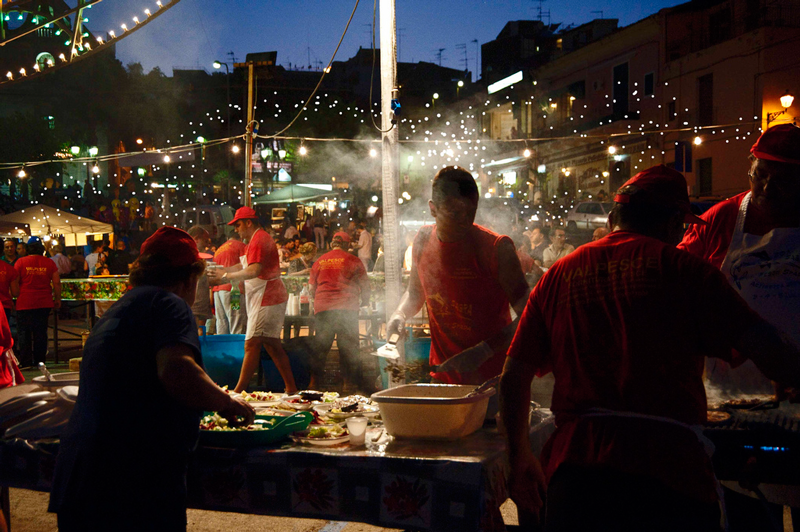
Busy cooking as night falls over the local “sagra”. Photo via Giuseppe Fraticelli under CC license.
Many of the small towns surrounding larger Italian cities hold le sagre, small town festivals revolving around a particular food. The food in question could range from risotto to ribs, chestnuts, asparagus, beer or anything else that is known to be sourced locally. Most popular in summer, going to a sagra is a fantastic way to experience the gastronomic specialty of any particular small town. To prepare for le sagre, enormous tents are erected in an open area that’s filled with tables and bench seating. On one end of the tenting you have the kitchen, where the food is being prepared and where cashiers take orders. In some cases, you will pay a fixed price at the entrance to a sagra and sit down for a pre-determined menu; be prepared with between about €5 and €15 per person in cash, most of these festivals do not accept cards or checks. To find out when and where the nearest sagre are, ask your concierge, or the concierge in any near-by hotel if you aren’t staying in one, and they should be able to give you all of the details, including what each festival offers.
A Tavola Non S’invecchia
These tips should give you a good foundation to get the most out of your dining experience in Italy. A few other things to keep in mind are that although the most authentic places are usually off the beaten path, there are many great restaurants in big cities as well, and the cities are also where you will find the most diversity when it comes to cuisine. With all of their idiosyncrasies, learning to dine like an Italian might not be easy, but you’ll be well on your way if you remember one thing, a tavola non s’invecchia, or, “at the table one does not age.” Take the time to enjoy every opportunity you have to eat in Italy rather than rushing onto the next thing and you’re sure to find yourself enjoying food like a local and are likely to learn a thing or two about the Italian lifestyle and culture while you’re at it.
